
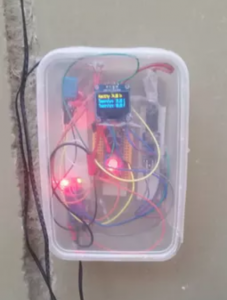
This is an automated plant watering system. The system detects when a plant is low on water and automatically waters it if it is. This a very useful application of the Arduino and is an example of a DIY project that would help out an elderly person. This project saves a lot of time and effort for the person.
]]>Short description: This person created a split-flap display that shows the weather including the temperature and conditions using abbreviations on the display based on the weather information from the Internet using Wi-Fi and a weather API app.
My response: I like this project and actually I’d like to have one because I always check the weather in the morning and when I’m in a hurry, even checking my phone (unlocking it, going through the weather app, waiting for it to connect) takes precious time. With this display, it would automatically show the weather like a calendar.
I would, though, wish it would show the weather conditions with diagrams instead of the abbreviations the creator made because it would be more intuitive to understand for people who, for instance, buy it. Abbreviations would be useful for the creator because he or she came up with it, but for people who use it the first time, they would have to learn the abbreviations first.
]]>Project creator: SparkFun
Short description: The Creative Engineer Sarah was using the fabric technique – smocking to create three unique fabric origami E-Textiles projects; a light up Space Invader, a light up sound sensor, and some Xbee buzzer paging pins.
Response: I am a costume designer. Those stocking techniques we use a lot in decorations in historic garments. I was surprised by the technology and historical effects combining together. I really like the sensor sample. I think it can use in the costumes in concerts or theatrical performance.
]]>Creator: Abdullah Sadiq
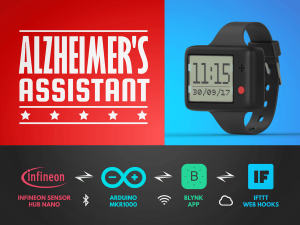
Description:
The Alzheimer’s Assistant is a system designed to help both patients and their caretakers. The creator set out a list of minimum goals. The system should be able to carry out the following tasks:
- Reminding the patient of carrying out tasks, he/she has to do daily (such as medications, exercise, etc)
- Monitor where the patient is in the house
- Alert the caretakers in case of an emergency of any sort
- Display the time (it’s a watch, after all!)
- It should be portable, and easy to use, even for an elder patient
- The cost should be kept to a minimum
He uses the following parts for the bare-bones project to function:
- Infineon’s Sensor Hub Nano
- Arduino MKR1000
- HC-05 Bluetooth Module
- Nokia 5110 Display
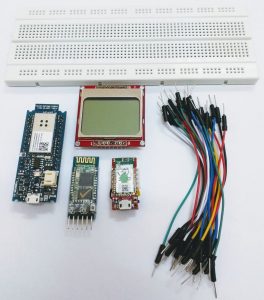 He uses an Infineon’s Sensor Hub Nano evaluation board because it has a DPS310 barometric pressure sensor, which sends its data through the evaluation board via bluetooth. But the issue was that the normal workflow required an android phone, which he didn’t want to be a requirement for the users. So, he uses an Arduino MKR1000 board due to its small form factor and WiFi capability. After parsing all the data compiled, he uses a display, connected to the Arduino, that interacts with the users, and show any messages, or to display the time or the data from the sensor.
He uses an Infineon’s Sensor Hub Nano evaluation board because it has a DPS310 barometric pressure sensor, which sends its data through the evaluation board via bluetooth. But the issue was that the normal workflow required an android phone, which he didn’t want to be a requirement for the users. So, he uses an Arduino MKR1000 board due to its small form factor and WiFi capability. After parsing all the data compiled, he uses a display, connected to the Arduino, that interacts with the users, and show any messages, or to display the time or the data from the sensor.
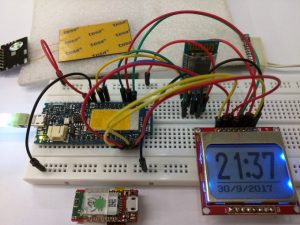
What it does:
- tells the time and date
- send reminders
- detects when you fall
- tracks your location
- measures temperature
- built in buzzer/vibrator to grab the users attention towards the watch
- a help button
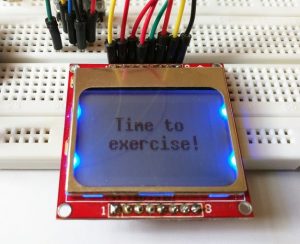

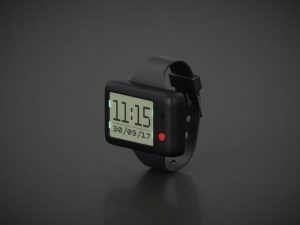
Response:
I personally think this project is well thought out and took into consideration the user experience. For example, if you’re someone with Alzheimer’s you might not realize you’re wearing a watch, but the built in buzzer alerts you and brings your attention to the watch. Even though that is a step in the right direction, what if the user does not know what the buzzer does? or forgets how to use parts of the watch? Other than that, I think the project would be very beneficial to both the patient and especially the caretakers, and hope the creator keeps working and realizing it.
Read more at: https://www.hackster.io/abdullahsadiq/alzheimer-s-assistant-a017ad
]]>
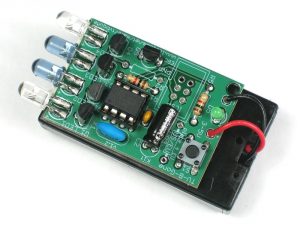
My preferred version of this project is a TV B Gone Jacket, adapted by Becky Stern. Her version of the project is sneaky and humorous, allowing you to cause pub chaos without risking getting kicked out with a half a pint left.
I enjoy this project because it does effectively what basic physical computation does best: spread joy and humor. It doesn’t take itself seriously, while still offering a useful resolution to a real, all american problem.
]]>
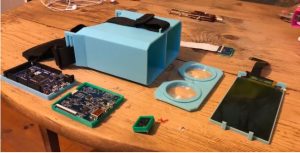
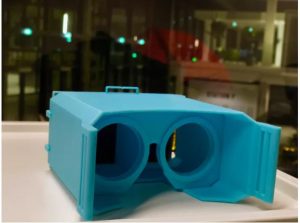 https://create.arduino.cc/projecthub/relativty/relativ-build-your-own-vr-headset-for-100-57adba?ref=platform&ref_id=424_trending__intermediate_&offset=4
https://create.arduino.cc/projecthub/relativty/relativ-build-your-own-vr-headset-for-100-57adba?ref=platform&ref_id=424_trending__intermediate_&offset=4
Created by Maxime Coutté , Jonas Ceccon, Gabriel Combe and their math teacher and my math teacher Jerome Dieudonne
Description: “We couldn’t afford an Oculus so we built one”
It is an open source VR headset that you can build yourself for $100.
This project is a great example of open source ingenuity. Made for very little money and it turned out really well. It’s easy to follow the process and the end result is fun. I like the sense of sharing and teamwork this project represents. The only improvement I would suggest is that it would be fun to try to make it even less expensive.
]]>Project Creator: raef_madin
Short Description: The Dance Pad was created to resemble a dance game such as DDR, when you step on arrows on a pad in time with music to score well in the game. Instead of a gaming system, this can be set up with an Arduino and a smartphone (plus additional parts).
Response: This definitely is an interesting design concept, making a game that many people enjoy more accessible or a fun project for people interested in building things with Arduinos to do. I did note a comment at the bottom saying that the arrows were random, so not aligned with the music, so perhaps integrating some technology with a beat counter might help, or pre-programming songs.
]]>Creator: Allen Pan
Description: Through combining a butane fuel chamber, solenoid valve, modified arc lighter, Arduino Pro Mini, and an accelerometer, you can shoot fire out of you hands like a real life fire bender. Now it’s time to stop the Avatar!
I think this project is great (though very dangerous) because like most people, I love the show Avatar: the last Airbender and who doesn’t think it’s super awesome to be able to shoot fire from your wrists? I feel like this is potentially quite dangerous in the wrong hands (get it) or if something malfunctions.
Personally I’d be interested in figuring out how to water or air bend using a similar idea (accelerometer detecting punches combined with an Arduino to set off a chain of events). How fun would it be to have a water gun fight with just your hands (assuming everything is encased so the components doesn’t get damaged)?
]]>Creator: Savio Dimatteo
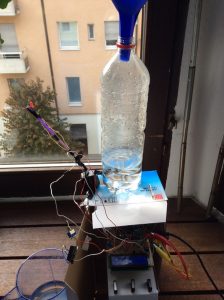
Short Description:
This system automatically pours out distinct volumes of water. It can be used to water plants when users are away (as shown), or anything else that needs water at set times.
Response: I think this is a cool project because of how useful yet simple it is. Having this tool would help maintain the life of gardens with very little maintenance. To improve this project, I would suggest an automatic timer system where a set amount of water is poured out after every set interval. Another option for improvement is to have a sensor in the dirt and have water poured out only when the water density drops below a certain point.
]]>
Project Creator: Ashley Hah and Marissa Kuhns
Short Description: A useful heart rate detection watch that can be worn doing training to show the heart rate level of the runner. Heart rate levels are shown by different colors of the watch in real time.
Response: I think the project is well designed, since changing color gives runners immediate feedback on their heart rate levels which make it possible for runners to adjust their speed at appropriate time. It would be better if the watch has internet or bluetooth connection so that it can send data back to the user and data can be analyzed to give the user better training plan.
]]>